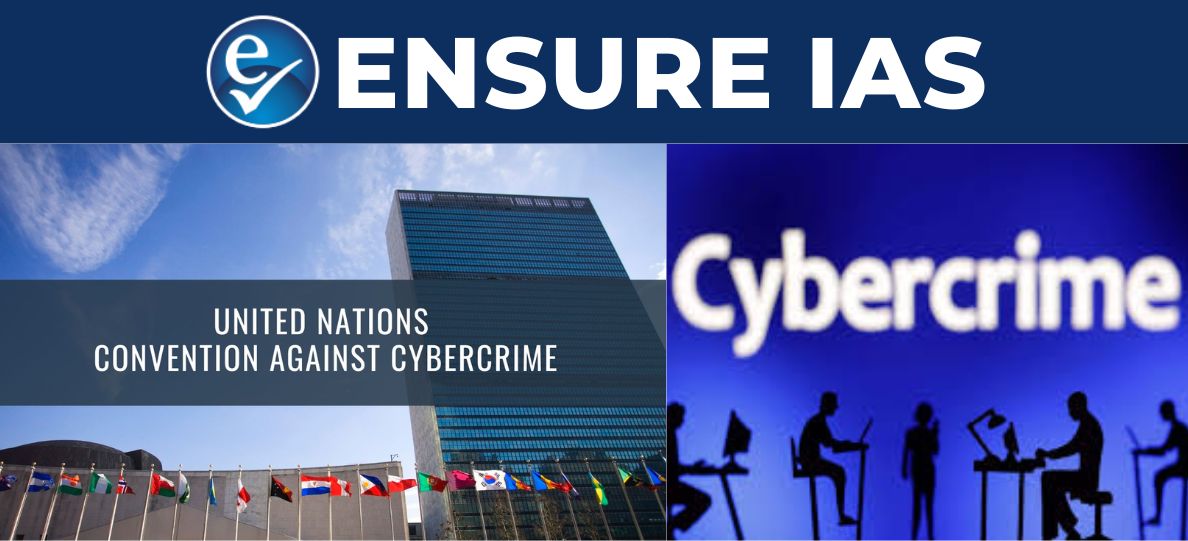- Courses
- GS Full Course 1 Year
- GS Full Course 2 Year
- GS Full Course 3 Year
- GS Full Course Till Selection
- Online Program
- GS Recorded Course
- NCERT (Recorded 500+ Hours)
- Polity Recorded Course
- Geography Recorded Course
- Economy Recorded Course
- AMAC Recorded Course
- Modern India, Post Independence & World History
- Environment Recoded Course
- Governance Recoded Course
- Science & Tech. Recoded Course
- International Relations and Internal Security Recorded Course
- Disaster Management Module Course
- Ethics Recoded Course
- Essay Recoded Course
- Current Affairs Recoded Course
- CSAT
- 5 LAYERED ARJUNA Mentorship
- Public Administration Optional
- ABOUT US
- OUR TOPPERS
- TEST SERIES
- FREE STUDY MATERIAL
- VIDEOS
- CONTACT US
United Nations Convention on Cybercrime
United Nations Convention on Cybercrime
08-02-2025

- The United Nations General Assembly has recently adopted the landmark United Nations Convention on Cybercrime, the first-ever legally binding UN instrument on cybercrime.
- This treaty is designed to combat the growing threat of cybercrime, strengthen international cooperation, and provide the legal framework necessary to address the challenges posed by cybercriminals.
- The convention has been adopted by 193 UN Member States by consensus.
- The convention will open for signature in Hanoi, Vietnam in 2025, with the United Nations Office on Drugs and Crime (UNODC) serving as secretariat.
- It will take effect after 40 states become parties to the agreement.
- Scope of Application
- Focuses on preventing, investigating, and prosecuting cybercrimes, including freezing, confiscating and returning crime proceeds.
- Involves collecting and sharing electronic evidence for criminal investigations.
Objectives of the UN Cybercrime ConventionThe Convention is intended to:
|
Key Provisions of the Convention
The Convention outlines several key provisions:
- International Cooperation & Data Sharing: Establishes mutual legal assistance, extradition, and a 24/7 network for immediate assistance, as well as cooperation for confiscation purposes.
- Procedural Measures: Provides guidelines for law enforcement agencies to preserve, search, and seize electronic data.
- Protection of Personal Data: Requires compliance with domestic privacy laws during data transfer, with safeguards in place. The Convention also encourages bilateral or multilateral agreements for easier data sharing.
- Protection of Human Rights: Ensures that human rights and freedoms are upheld during the implementation of the Convention.
- Other Provisions: Includes guidelines for extradition, the transfer of sentenced persons, criminal proceedings, and joint investigations.
Cybercrime Offenses CriminalizedThe Convention criminalizes the following key offenses:
|
Why the Convention against Cybercrime matters?
- Increased Connectivity and associated Vulnerability: With over 67% of the global population now online (World Bank), cybercrime risks are widespread.
- Southeast Asia has emerged as a "ground zero" for organized cybercrime, with sophisticated operations threatening economies and infrastructure.
- The threat is escalating, undermining economies, disrupting critical infrastructure, and eroding trust in digital systems.
- Around-the-Clock Cooperation: Transnational crime investigations rely on electronic evidence, which is often decentralized and spread across jurisdictions.
- Quick access is crucial to prevent tampering or deletion. The Convention establishes frameworks for accessing and sharing electronic evidence to support investigations and prosecutions.
- Transnational Nature of Cybercrime: Cybercrimes often involves cross- border transactions and targeting wherein criminals operate from one country while targeting victims in another.
- Thus, handling transnational and organised crimes requires a coordinated global law enforcement response to dismantle their networks and prevent the spread of their activities.
- Adapting to Rapid Technological Advancements: Technologies like AI and 3D printing pose dual-use risks, outpacing policymakers' ability to adapt (UNIDIR).
- Example: While the 1880s electric grid took 50 years to reach 100 million homes, ChatGPT achieved this in just two months (2022).
- Protecting children: Online platforms such as social media, chat apps and games offer anonymity that predators can exploit to groom, manipulate, or harm children.
- By criminalising these offenses, the Convention equips governments with stronger tools to protect children and bring perpetrators to justice.
- Rehabilitation and Justice for Victims: Treaty acknowledges the growing number of cybercrime victims and emphasizes securing justice while addressing the needs of vulnerable individuals in prevention and response measures.
The adoption of the United Nations Convention on Cybercrime marks a significant milestone in the global fight against cybercrime. It highlights the success of multilateralism during challenging times and reflects the collective will of member states to enhance international cooperation in the prevention and prosecution of cybercrimes. This treaty, the first international criminal justice agreement in over 20 years, will play a crucial role in combating cybercrime and securing a safer digital future for the world.
|
Also Read |
|
| Public Administration Optional | |
| Question Answer Practice For UPSC | |
PLFS 2025: Monthly Jobs Data, Bigger Survey
PLFS 2025: Monthly Jobs Data, Bigger Survey


